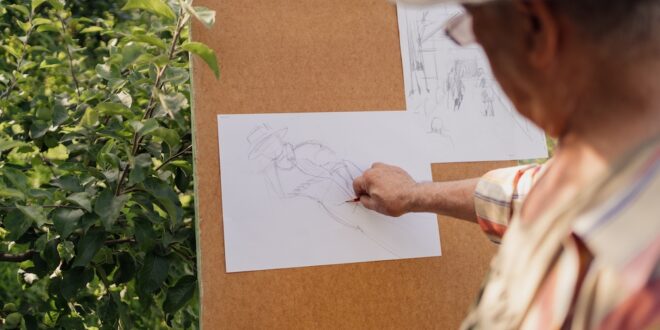You don’t have to be an artist to get the brain boost!
You stop, stand in the middle of the room, and wonder what it is you came in for. You retrace your steps, hoping this will jog your memory or illicit some clues. This is nothing new to most seniors, who battle daily with the cognitive challenge of memory loss – even if it is mild. While the suggestions for slowing or decreasing memory loss are many (for example: engaging in word games, puzzles, jigsaws, learning a new language or instrument, or singing, socialising, and crafting), the secret to sticking at them is finding one that suits your style of thinking. That’s why those who operate at a visual level (people, for example, who can conjure up images in their brain with ease or who use visual clues to help them navigate or remember) will be excited to learn daily drawing can help enhance memory. What’s more, researchers have found drawing (even for those who may not be very adept at it) can be a more effective memory jogger than, say, writing reminder notes or repeating a word over and over again.
Best of all, drawing (as a way of assisting memory) is more effective for older adults than it is for younger people. This is because, as we age, our cognitive decline is more in the area of remembering words and attending to multi-tasking. The region of the brain less affected by ageing is the area involved in processing images and pictures.
If you consider yourself a visual thinker but not an artist, there’s no need to be concerned. The quality of the drawing you produce isn’t connected with the benefit it provides to your brain. In fact, artistic ability doesn’t even come into it. It’s what takes place as you draw that’s important. When we pick up a pen and begin to sketch, we’re using a whole range of memory skills simultaneously. We’re using our visual memory (to record an image), our semantic memory (our long term general knowledge about the world and how it looks), our kinaesthetic memory (how to physically manipulate an object such as a pen or pencil), and our spatial memory (which includes navigation and how 3 dimensional objects interact with each other). That’s a lot of memorising going on at one time, and it stimulates the mind and can potentially help to build new brain cells. It makes sense, then, that drawing on a daily basis is worth trying.
Let’s get started
If you want to try drawing as part of assisting your memory, there are a number of entertaining ways you can do it. Here are just a few to get you started:
· Place a free-standing mirror on the breakfast table. While you have breakfast, look into the mirror and draw a self-portrait. Try using a sketchbook to store your portraits. Over a period of time, you’ll be surprised at how different each one is – even though they’re all of you!
· Look at a simple object (such as a chair or cup), then record it on paper from memory (i.e. don’t look at the object again until your drawing of it is completed).
· Each day, draw the same household object or scene from a window, but do it to a time limit (set your phone alarm to 5 minutes, for example). As with the self-portraits, keep a record and see how your drawings change over time.
· Team up with a friend to a daily drawing challenge, then photograph your efforts and send them to each other! You could also do this with your grandchildren.
As seniors, we owe it ourselves to keep our brains in shape. And while some exercises will suit an individual better than others, mixing it up is the way to go. Add daily drawing to your memory-boosting tool kit, and enjoy the routine!









Join the Discussion
Type out your comment here:
You must be logged in to post a comment.